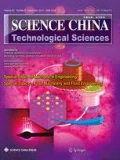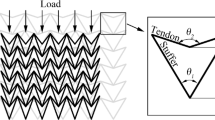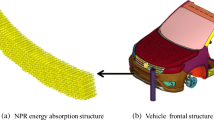Abstract
A cylindrical negative Poisson’s ratio (CNPR) structure based on two-dimensional double-arrow negative Poisson’s ratio (NPR) structure was introduced in this paper. The CNPR structure has excellent stiffness, damping and energy absorption performances, and can be applied as spring, damper and energy absorbing components. In this study, the CNPR structure was used as a jounce bumper in vehicle suspension, and the load-displacement curve of NPR jounce bumper was discussed. Moreover, the influences of structural parameters and materials on the load-displacement curve of NPR jounce bumper were specifically researched. It came to the conclusion that only the numbers of cells and layers impact the hardening displacement of NPR jounce bumper. And all parameters significantly affect the structure stiffness at different displacement periods. On the other hand, the load-displacement curve of NPR jounce bumper should be in an ideal region which is difficult to be achieved applying mathematical optimization method. Therefore, a parametric design strategy of NPR jounce bumper was proposed according to the parametric analysis results. The design strategy had two main steps: design of hardening displacement and design of stiffness. The analysis results proved that the proposed method is reliable and is also meaningful for relevant structure design problem.
Similar content being viewed by others
References
Lakes R. Foam structures with a negative Poisson’s ratio. Science, 1987, 235: 1038–1040
Larsen U D, Signund O, Bouwsta S. Design and fabrication of compliant micromechanisms and structures with negative Poisson’s ratio. J Microelectromech Syst, 1997, 6: 99–106
Liu Y, Ma Z D. Nonlinear analysis and design investigation of a negative Poisson’s ratio material. In: 2007 ASME International Mechanical Engineering Congress and Exposition. Seattle, Washington, 2007
Zhang W, Ma Z, Hu P. Mechanical properties of a cellular vehicle body structure with negative Poisson’s ratio and enhanced strength. J Reinf Plast Compos, 2014, 33: 342–349
Ma Z D, Bian H X, Sun C, et al. Functionally-graded NPR (negative Poisson’s ratio) material for a blast-protective deflector. In: 2010 NDIA Ground Vehicle Systems Engineering and Technology Symposium. Dearborn, 2010
Zhou G, Ma Z D, Li G, et al. Design optimization of a novel NPR crash box based on multi-objective genetic algorithm. Struct Multidisc Optim, 2016, 54: 673–684
Zhou G, Zhao W Z, Ma Z D, et al. Multi-objective robust design optimization of a novel negative Poisson’s ratio bumper system. Sci China Tech Sci, 2017, 60: 1103–1110
Smardzewski J, Kłos R, Fabisiak B. Design of small auxetic springs for furniture. Mater Des, 2013, 51: 723–728
Wang K, Chang Y H, Chen Y W, et al. Designable dual-material auxetic metamaterials using three-dimensional printing. Mater Des, 2015, 67: 159–164
Qi C, Yang S, Wang D, et al. Ballistic resistance of honeycomb sandwich panels under in-plane high-velocity impact. Sci World J, 2013, 2013: 1–20
Zied K, Osman M, Elmahdy T. Enhancement of the in-plane stiffness of the hexagonal re-entrant auxetic honeycomb cores. Phys Status Solidi B, 2015, 252: 2685–2692
Prall D, Lakes R S. Properties of a chiral honeycomb with a Poisson’s ratio of −1. Int J Mech Sci, 1997, 39: 305–314
Alderson A, Alderson K L, Attard D, et al. Elastic constants of 3-, 4- and 6-connected chiral and anti-chiral honeycombs subject to uniaxial in-plane loading. Compos Sci Technol, 2010, 70: 1042–1048
Miller W, Smith C W, Scarpa F, et al. Flatwise buckling optimization of hexachiral and tetrachiral honeycombs. Compos Sci Technol, 2010, 70: 1049–1056
Lorato A, Innocenti P, Scarpa F, et al. The transverse elastic properties of chiral honeycombs. Compos Sci Technol, 2010, 70: 1057–1063
Abramovitch H, Burgard M, Edery-Azulay L, et al. Smart tetrachiral and hexachiral honeycomb: Sensing and impact detection. Compos Sci Technol, 2010, 70: 1072–1079
Grima J N, Gatt R. Perforated sheets exhibiting negative Poisson’s ratios. Adv Eng Mater, 2010, 12: 460–464
Attard D, Grima J N. A three-dimensional rotating rigid units network exhibiting negative Poisson’s ratios. Phys Status Solidi B, 2012, 249: 1330–1338
Attard D, Caruana-Gauci R, Gatt R, et al. Negative linear compressibility from rotating rigid units. Phys Status Solidi B, 2016, 253: 1410–1418
Shufrin I, Pasternak E, Dyskin A V. Planar isotropic structures with negative Poisson’s ratio. Int J Solids Struct, 2012, 49: 2239–2253
Shufrin I, Pasternak E, Dyskin A V. Negative Poisson’s ratio in hollow sphere materials. Int J Solids Struct, 2015, 54: 192–214
Bertoldi K, Reis P M, Willshaw S, et al. Negative Poisson’s ratio behavior induced by an elastic instability. Adv Mater, 2010, 22: 361–366
Hou X, Hu H, Silberschmidt V. A novel concept to develop composite structures with isotropic negative Poisson’s ratio: Effects of random inclusions. Compos Sci Technol, 2012, 72: 1848–1854
Hou X, Hu H, Silberschmidt V. Numerical analysis of composite structure with in-plane isotropic negative Poisson’s ratio: Effects of materials properties and geometry features of inclusions. Compos Part B-Eng, 2014, 58: 152–159
Shan S, Kang S H, Zhao Z, et al. Design of planar isotropic negative Poisson’s ratio structures. Extreme Mech Lett, 2015, 4: 96–102
Elipe J C A, Lantada A D. Comparative study of auxetic geometries by means of computer-aided design and engineering. Smart Mater Struct, 2012, 21: 105004
Xu B, Arias F, Brittain S T, et al. Making negative Poisson’s ratio microstructures by soft lithography. Adv Mater, 1999, 11: 1186–1189
Scarpa F, Smith C W, Ruzzene M, et al. Mechanical properties of auxetic tubular truss-like structures. Phys Status Solidi B, 2008, 245: 584–590
Karnessis N, Burriesci G. Uniaxial and buckling mechanical response of auxetic cellular tubes. Smart Mater Struct, 2013, 22: 84008
Sun Y, Pugno N. Hierarchical fibers with a negative Poisson’s ratio for tougher composites. Materials, 2013, 6: 699–712
Wang Y, Wang L, Ma Z D, et al. Parametric analysis of a cylindrical negative Poisson’s ratio structure. Smart Mater Struct, 2016, 25: 035038
Wang Y, Wang L, Ma Z, et al. A negative Poisson’s ratio suspension jounce bumper. Mater Des, 2016, 103: 90–99
Dickson D G. A primer on jounce bumper design using microcellular polyurethane. SAE Technical Paper. Detroit, 2004
Dickson D G, Schranz S, Wolff M. Microcellular polyurethane jounce bumper design and the effects on durability. SAE Technical Paper. Detroit, 2005
Wang Y, Ma Z, Wang L. A finite element stratification method for a polyurethane jounce bumper. Proc Inst Mech Eng D-J Automob Eng, 2016, 230: 983–992
Kim C, Ro P I, Kim H. Effect of the suspension structure on equivalent suspension parameters. Proc Inst Mech Eng D-J Automob Eng, 1999, 213: 457–470
Wang Y, Wang L, Ma Z, et al. Finite element analysis of a jounce bumper with negative Poisson’s ratio structure. Proc Inst Mech Eng CJ Mech Eng Sci, 2017, 231: 4374–4387
Wang Y, Zhao W, Zhou G, et al. Optimization of an auxetic jounce bumper based on Gaussian process metamodel and series hybrid GASQP algorithm. Struct Multidisc Optim, 2017, 70: doi: 10.1007/s00158-017-1869-z
Zhou G, Duan L B, Zhao W Z, et al. An enhanced hybrid and adaptive meta-model based global optimization algorithm for engineering optimization problems. Sci China Tech Sci, 2016, 59: 1147–1155
Author information
Authors and Affiliations
Corresponding author
Rights and permissions
About this article
Cite this article
Wang, Y., Zhao, W., Zhou, G. et al. Parametric design strategy of a novel cylindrical negative Poisson’s ratio jounce bumper for ideal uniaxial compression load-displacement curve. Sci. China Technol. Sci. 61, 1611–1620 (2018). https://doi.org/10.1007/s11431-017-9194-2
Received:
Accepted:
Published:
Issue Date:
DOI: https://doi.org/10.1007/s11431-017-9194-2




